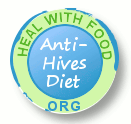Diet for Preventing Hives: Quercetin, Vitamin C, Omega-3 Fatty Acids and More

A diet rich in quercetin, vitamin C, and anti-inflammatory omega-3 fatty acids can help prevent and treat hives. Furthermore, avoiding allergenic foods can bring relief from hives. You can try using an elimination diet to identify which foods cause or worsen your hives symptoms. To learn more about the elimination diet and the nutrients that help prevent hives outbreaks, continue reading.
Important notice: The information below and elsewhere on this website should not be taken as a substitute for professional medical or nutritional advice. Always seek the advice of a qualified health care professional or nutritionist for any questions you may have regarding chronic hives (urticaria) or any other medical condition.
#1: Eat Plenty of Foods That Contain Quercetin
There is some evidence suggesting that the bioflavonoid quercetin may help control hives in susceptible individuals. In addition to having antioxidant and anti-inflammatory properties, quercetin has antihistamine activity. It prevents immune cells from releasing histamine, a substance that causes allergic reactions such as allergic rhinitis, hives, and other skin rashes. Some of the best dietary sources of quercetin include apples, capers, yellow and red onions, lovage, broccoli, and many berries.
#2: Step Up Your Vitamin C Intake
Research investigating the ability of vitamin C (ascorbic acid) to alleviate hives is limited. However, in theory, a large amount of vitamin C in the diet might help prevent hives symptoms due to the ability of this powerful vitamin to reduce histamine release in the body and to make histamine break down faster. The positive effects of vitamin C on allergies may be more pronounced when vitamin C is consumed together with vitamin E because these two vitamins work synergistically and protect each other.
#3: Limit Omega-6 Fats, Consume More Omega-3 Fats
Omega-6 fatty acids are considered essential fatty acids (EFAs), and a certain amount is necessary for the proper functioning of the human body. However, excessive amounts of these fats can be harmful to people with hives. Excess omega-6 fatty acids can increase inflammation in the body by producing inflammatory prostaglandins ("type 2 prostaglandins").
Omega-3 fatty acids, on the other hand, have anti-inflammatory effects. Many experts believe that our ancestors consumed omega-3 and omega-6 fatty acids in roughly equal amounts. Most modern diets in Western countries include too much of the potentially inflammatory omega-6 fatty acids and not enough of the anti-inflammatory omega-3 acids. Simply consuming less refined vegetable oils like corn oil and safflower oil—which are high in omega-6 fatty acids—and including more foods rich in omega-3 fatty acids in the diet (e.g. flaxseeds, walnuts, soybeans, and cold water fish like salmon, cod, and halibut) can help prevent hives outbreaks and bring relief from existing symptoms.
#4: Eliminate Food Allergens
People suffering from hives, particularly those with chronic hives, are often allergic to certain foods or food substances which cause their symptoms. What causes hives in one person, however, may not cause the same reaction in another person. Nevertheless, it is possible to point to some foods that are more likely to trigger allergic reactions leading to hives. These foods include chicken, eggs, dairy products, cured meat, chocolate, alcoholic beverages, citrus fruits, shellfish, wheat and nuts.
Other common allergens in people with hives include certain food additives and preservatives such as benzoates, tartrazine, and sulfites. Benzoates are antimicrobial preservatives that used in various products, particularly in soft drinks. Tartrazine is an artificial food coloring used in many processed foods in varying proportions. Products that may contain tartrazine include candy, confectionery, soft drinks, canned vegetables, cereals, chips, pickled goods, instant soups and sauces, some rices, some pastas, cheese and butter. Sulfites are used as preservatives in many packaged foods and alcoholic beverages. The best way to avoid artificial substances in food is to opt for unprocessed, organic foods.
If you suffer from chronic hives, you may want to try an elimination diet to identify which foods and substances may contribute to hives symptoms in your case. This diet involves avoiding all foods and substances that may be causing hives symptoms for two to four weeks. If, after this elimination period, symptoms have cleared or improved significantly, the suspected foods and substances can be re-introduced to the diet, one food or substance at a time (this is the so-called "challenge" phase of the elimination diet). During this phase, the patient systematically goes through all the suspected allergens, one by one, by consuming a suspect food or substance several times a day and then returning to the elimination diet for a few days. If the patient's hives symptoms get worse during these days, he or she may be allergic to the food or chemical that was re-introduced.

